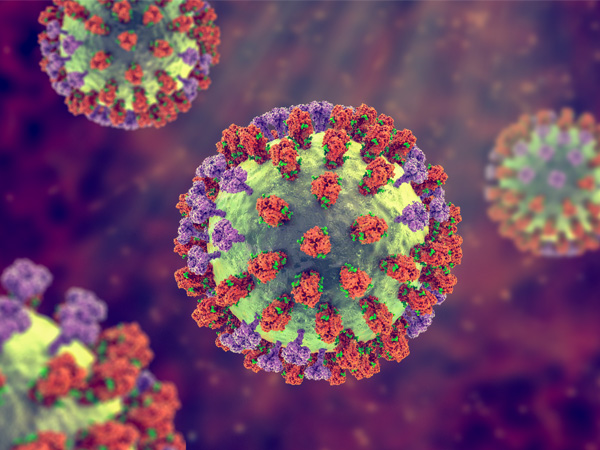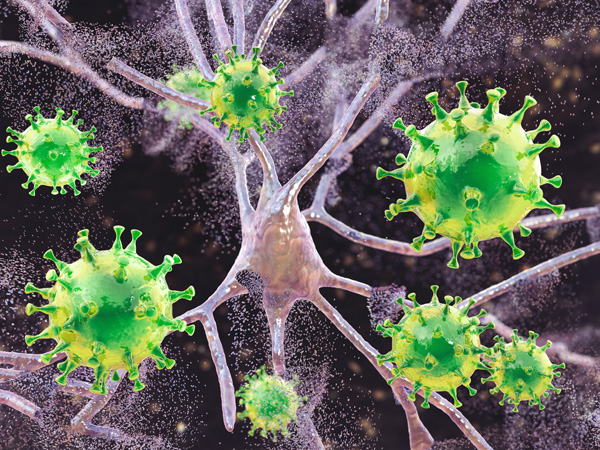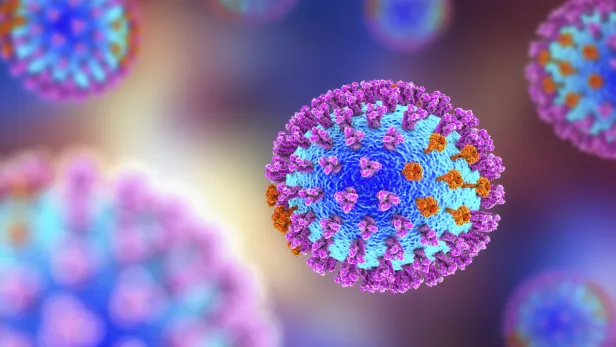- Home
- Science
- Diseases & Conditions
- Influenza (Flu)
What Is Influenza?
Also known as the flu, influenza is a contagious illness in the respiratory tract that infects the nose and throat and can move into the lungs. It is caused by influenza viruses, which cause illness that ranges from mild to severe. In the worst cases, influenza can lead to death. Annual vaccination is the best way to avoid the flu.1
Each year, anywhere from 290,000 to 650,000 people worldwide die from influenza-related respiratory illnesses.2 The flu burdens the United States with billions of dollars of medical costs and has caused up to 52,000 deaths nationwide in a year.3,4 However, advancements in vaccinations are helping to turn the tide on the potentially deadly virus.5
Causes and Risk Factors
What Causes Influenza?
Influenza viruses cause the flu. There are four types of flu viruses: influenza A, B, C and D.6 The viruses tend to change in two ways: antigenic drift and antigenic shift. Small gene mutations cause drift and can add up to significant variations over time. Shifts, which are rarer, represent a sudden, major change in a virus, resulting in new proteins in flu viruses that infect humans. Shift can occur if a flu virus in an animal population gains the ability to infect humans. Both processes help create viruses that our immune systems fail to recognize and neutralize. As a result, people can catch the flu more than once, and experts must constantly update vaccines.7

How Does Influenza Spread?
Influenza spreads from person to person, mainly via droplets generated when people with the flu sneeze, cough, or talk. These droplets can infect others up to about 6 feet away if they enter their mouths or noses. Though less common, the flu can also be transmitted by touching an object or surface that has the flu virus on it and then touching the mouth, nose, or eyes.8 People who carry the flu virus are most highly contagious within the first three to four days after they get sick. Still, most healthy adults can infect others a day before symptoms develop and up to seven days after they become ill. People with weakened immune systems and children may be contagious for even longer. Most often, symptoms begin around two days after the virus finds its way into the body.8
How To Prevent the Flu
According to the Centers for Disease Control and Prevention (CDC), the best way to prevent seasonal influenza is to get the annual flu vaccine. Robust evidence suggests that the flu vaccine prevents many people from getting sick. If people do get sick after getting vaccinated, their illness is less severe. Vaccination also reduces the risk of flu-associated hospitalization, can be lifesaving for children, and can protect people with chronic health problems from developing serious symptoms of the flu.9
Because the influenza virus is constantly evolving, the World Health Organization convenes twice a year to identify viruses for inclusion in seasonal influenza vaccines.10
The CDC recommends an annual influenza vaccine for everyone aged 6 months or older. CDC guidelines state that pregnant people and people with certain chronic conditions can get the flu shot but should avoid certain types of vaccines and some defined groups should not get the vaccine:11
- People with severe, life-threatening allergies to ingredients in the flu vaccine
- People who have had a severe allergic reaction to a dose of influenza vaccine before
The CDC states that influenza vaccines help the body develop antibodies within about two weeks and are available in both shot and nasal spray form.12 The nasal spray vaccine is made from a live but weakened virus and is designed to protect against four flu viruses: two strains of influenza A and two strains of influenza B. The CDC only recommends the spray for healthy people between the ages of 2 and 49 who are not pregnant, and it warns that people with certain medical conditions should not use the nasal spray vaccine.13
Prevention Beyond Vaccines
Generally, good health habits are also helpful precautions against influenza. These include:14
- Washing your hands often with warm water for 30 seconds (the time it takes to sing “Happy Birthday” two times)
- Using hand sanitizer
- Keeping distance from those who are sick
- Staying home from work, school, and other public places when sick
- Covering your mouth and nose with a tissue or elbow—not your hands—when sneezing or coughing.
Who Is at Risk From the Flu?
Some people are at higher risk of developing serious complications from the flu. They include:15
- Adults 65 and older
- Pregnant people
- People with asthma, cancer, or HIV/AIDS
- People with certain disabilities
- People with heart disease, diabetes, or chronic kidney disease
- People who have had a stroke
Some racial and ethnic groups experience higher rates of severe influenza. This includes people who are non-Hispanic Black, American Indian or Alaska Native, Hispanic, or of Latin descent.16
How Many Types of Influenza Are There?
There are four types of influenza viruses: influenza A, influenza B, influenza C, and influenza D. The A and B viruses cause seasonal epidemics in humans—commonly referred to as “flu season”—which tend to occur in winter.
Flu pandemics are only known to be the result of influenza A.6 These pandemics can happen when a different and new influenza A virus infects people and spreads easily among populations.6
Influenza A viruses are split into subtypes according to two proteins on the virus surface: hemagglutinin (H) and neuraminidase (N). Hemagglutinin has 18 subtypes—H1 through H18. Neuraminidase has 11—N1 through N11. The CDC uses international naming conventions for new influenza viruses (for example, H1N1 and H3N2).6
Unlike influenza A, influenza B is not divided into subtypes, but instead has two “lineages” called B/Victoria and B/Yamagata. Influenza A viruses change faster than influenza B viruses.6
Influenza C viruses typically cause mild illness and are largely believed not to cause epidemics in humans.
Influenza D mostly affects cattle and does not appear to make humans sick.6
Influenza Symptoms
Flu symptoms range from mild to severe and, in serious cases, can even cause death. The flu usually begins suddenly and causes symptoms, including:17
- Cough
- Sore throat
- Stuffy or runny nose
- Fever or chills
- Muscle or body aches
- Headaches
- Fatigue or tiredness.
Although less common, some people with the flu experience vomiting and diarrhea. These are more common in children than adults.17

Influenza Complications
According to the CDC, most people recover from the flu between a few days and two weeks; however, some people develop complications that can be dangerous and even deadly: sinus and ear infections, myocarditis (inflammation of the heart), encephalitis (inflammation of the brain), rhabdomyolysis (inflammation of muscle tissues), and multi-organ failure, including kidney or respiratory failure. Influenza can trigger severe inflammatory responses that lead to sepsis. The infection can also exacerbate chronic medical conditions such as asthma and chronic heart disease.17 Some studies suggest that influenza infection is linked with an increase in heart attacks and strokes.18

Diagnosis and Treatment
Influenza Diagnosis
If you're worried that someone has the flu, rapid influenza diagnostic tests are easy to perform and provide results in about 15 minutes. Still, false negatives, or negative tests in people who actually have an influenza infection, are common. Keep in mind that some tests distinguish between influenza A and B viruses, while others do not.19
Flu vs. Common Cold vs. COVID-19 vs. Allergies
The flu and COVID-19 stem from different contagious viruses, but they can cause similar symptoms. The most reliable way to tell the difference is to get tested.20
Flu symptoms usually develop more quickly, between one to four days, while COVID-19 symptoms usually appear five days after infection, but this window can extend from two to 14 days. The flu tends to be more severe than the common cold or allergies.20
Influenza Treatment
According to the CDC, the flu can be treated with antiviral drugs, which help alleviate symptoms and shorten the duration of illness by a day. These influenza medications are available in the form of pills, liquid, inhaled powders, or intravenous solutions. They are accessible only with a prescription from a healthcare provider and cannot be bought over the counter.21
The CDC says that antivirals for influenza work best when started within two days of getting sick. Taking them later can still be effective, especially for people at higher risk for severe complications or who are in the hospital with severe illness. Antivirals may also help lower the risk of some complications, including respiratory illnesses that require antibiotics. People who are at higher risk for serious complications should contact their doctor immediately to receive swift treatment if they have the flu or suspect infection.21
The CDC also recommends that anyone who gets the flu should stay at home and rest when possible, avoiding close contact with people in their household. They should also, the CDC says, drink plenty of water to prevent dehydration.22
The CDC outlines specific recommendations when caring for someone who has the flu. This includes avoiding being face to face and spending the least amount of time possible in close contact with them. Further, they say, when holding sick children, keep their chin on your shoulder so they cannot cough or sneeze directly in your face. They suggest keeping up good hand-washing habits and using alcohol-based hand rubs, especially after touching infected people. Specifically, they say, wash your hands after handling their tissues or laundry.22
The CDC recommends seeking immediate medical care if a person is having trouble breathing, is not urinating, or is experiencing severe muscle pain, seizures, or a fever or cough that improves but then returns or worsens. And in children, seek immediate attention if they have a fever above 104 degrees Fahrenheit or any fever if under 12 weeks old.23
As the CDC recommends, vaccines help prevent flu and antivirals are useful for treatment.9,21 However, other remedies can also help patients manage symptoms. Hydration is important to prevent dehydration—water, juice, and warm soup all work well. Rest helps your body fight the illness. And over-the-counter pain relievers can help minimize the aches and pains that you might experience while sick.24
Global Impact

An H1N1 flu virus caused one of the most devastating pandemics in modern history. From 1918 to 1919, it spread globally, infecting approximately half a billion people—a third of the world's population at the time. The virus killed about 50 million people worldwide and about 675,000 in the United States.25
Influenza viruses continue to infect people around the world today. Outbreaks tend to coincide with winter seasons in temperate climates, but influenza can circulate throughout the year in tropical regions.26 Altogether, there are about a billion influenza cases a year. Of these, about three to five million cases are severe, and 290,000 to 650,000 cause influenza-related respiratory deaths.2
The World Health Organization has developed a plan through 2030 to attain the highest possible level of influenza prevention and control, reducing the burden of seasonal influenza and mitigating the impact of pandemic influenza. The strategy calls for supporting better global tools and strengthening countries’ capacities.2 The CDC collaborates with the WHO, collecting and analyzing influenza viruses from around the world.27
Frequently Asked Questions About Influenza
- Can I get the flu after being vaccinated?
Yes, but, according to the CDC, the vaccine is the best way to protect against infection. Those who get sick after being vaccinated may have less severe illness and may be less likely to be admitted to hospital intensive care units or die. Protection against the flu varies depending on a range of factors, including health and age.28
- What’s the difference between the flu and COVID-19?
Both illnesses originate with a viral infection, causing cough, fever, and body aches that may progress to pneumonia. Both present cases ranging from asymptomatic to mild, severe, and even sometimes fatal. They both spread in similar ways. There are vaccines available for each and other precautions for both include mask-wearing, hand-washing, and staying away from others when sick. However, they are caused by different viruses. COVID-19 symptoms may include a loss of smell or taste, which rarely happens with the flu.29
- Is it possible to have the flu and COVID-19 at the same time?
Yes. This is known as coinfection.30
- How many people die from the flu?
The number of people who die from influenza varies from year to year, depending on viruses' characteristics and other factors. Between 2010 and 2020 in the United States, influenza caused from 12,000 to as many as 52,000 deaths a year.4
- How long has the flu been around?
The writings of Hippocrates include a mention of an influenza-like illness in 412 BC, in the Book of Epidemics, which is considered by some historians to be the first historical description of influenza.31
Learn More About Influenza
Find a Pfizer clinical trial for influenza at PfizerClinicalTrials.com.
Explore influenza clinical trials at ClinicalTrials.gov.
Area of Focus: Vaccines
Influenza is a focus of Pfizer’s Vaccines Therapeutic Area. Visit the Vaccines Page.
- References
- Key facts about influenza (flu). Centers for Disease Control and Prevention. https://www.cdc.gov/flu/about/keyfacts.htm. Last reviewed August 26, 2021. Accessed August 1, 2022.
- Global influenza strategy 2019-2030. World Health Organization. https://apps.who.int/iris/bitstream/handle/10665/311184/9789241515320-eng.pdf. Accessed August 1, 2022.
- Putri WCWS, Muscatello DJ, Stockwell MS, Newall AT. Economic burden of seasonal influenza in the United States. Vaccine. 2018;36(27):3960-3966. doi:10.1016/j.vaccine.2018.05.057
- Disease Burden of Flu. Centers for Disease Control and Prevention. https://www.cdc.gov/flu/about/burden/index.html. Last reviewed January 7, 2022. Accessed August 1, 2022.
- Influenza Vaccine Advances. Centers for Disease Control and Prevention. https://www.cdc.gov/flu/prevent/advances.htm. Last reviewed September 10, 2021. Accessed August 1, 2022.
- Types of Influenza Viruses. Centers for Disease Control and Prevention. https://www.cdc.gov/flu/about/viruses/types.htm. Last reviewed November 2, 2021. Accessed August 1, 2022.
- How Flu Viruses Can Change: “Drift” and “Shift”. Centers for Disease Control and Prevention. https://www.cdc.gov/flu/about/viruses/change.htm. Last reviewed September 21, 2021. Accessed August 1, 2022.
- How flu spreads. Centers for Disease Control and Prevention. https://www.cdc.gov/flu/about/disease/spread.htm. Last reviewed August 27, 2018. Accessed August 1, 2022. Last reviewed August 27, 2018. Accessed August 1, 2022.
- What are the benefits of flu vaccination? Centers for Disease Control and Prevention. https://www.cdc.gov/flu/prevent/vaccine-benefits.htm. Last reviewed August 26, 2021. Accessed August, 2022.
- Global Influenza Programme: Vaccines. World Health Organization. https://www.who.int/teams/global-influenza-programme/vaccines. Accessed August 1, 2022.
- Who should and who should NOT get a flu vaccine. https://www.cdc.gov/flu/prevent/whoshouldvax.htm. Last reviewed July 27, 2022. Accessed August 1, 2022.
- Different Types of Flu Vaccines. Centers for Disease Control and Prevention. https://www.cdc.gov/flu/prevent/different-flu-vaccines.htm. Last reviewed October 25, 2021. Accessed August 1, 2022.
- Live Attenuated Influenza Vaccine [LAIV] (The Nasal Spray Flu Vaccine). Centers for Disease Control and Prevention. https://www.cdc.gov/flu/prevent/nasalspray.htm. Last reviewed July 26, 2022. Accessed August 1, 2022.
- Preventing Flu. American Lung Association. https://www.lung.org/lung-health-diseases/lung-disease-lookup/influenza/preventing-influenza. Last updated November 4, 2021. Accessed August 1, 2022.
- People at higher risk of flu complications. Centers for Disease Control and Prevention. https://www.cdc.gov/flu/highrisk/index.htm. Last updated November 18, 2021. Accessed February 16, 2022. Last updated November 18, 2021. Accessed February 16, 2022.
- Flu Disparities Among Racial and Ethnic Minority Groups. Centers for Disease Control and Prevention. https://www.cdc.gov/flu/highrisk/disparities-racial-ethnic-minority-groups.html. Last reviewed November 9, 2021. Accessed August 1, 2022. Last reviewed November 9, 2021. Accessed August 1, 2022.
- Flu Symptoms & Complications. Centers for Disease Control and Prevention. https://www.cdc.gov/flu/symptoms/symptoms.htm. Last reviewed September 21, 2021. Accessed August 1, 2022. Last reviewed September 21, 2021. Accessed August 1, 2022.
- Flu & People with Heart Disease or History of Stroke. Centers for Disease Control and Prevention. https://www.cdc.gov/flu/highrisk/heartdisease.htm. Last reviewed August 26, 2021. Accessed August 1, 2022.
- Rapid Influenza Diagnostic Tests. Centers for Disease Control and Prevention. https://www.cdc.gov/flu/professionals/diagnosis/clinician_guidance_ridt.htm. Last reviewed October 25, 2016. Accessed August 1, 2022. Last reviewed October 25, 2016. Accessed August 1, 2022.
- Is It Flu, COVID-19, Allergies, or a Cold? News in Health. https://newsinhealth.nih.gov/2022/01/it-flu-covid-19-allergies-or-cold. Published January 2022. Accessed August 1, 2022. Published January 2022. Accessed August 1, 2022.
- What You Should Know About Flu Antiviral Drugs. Centers for Disease Control and Prevention. https://www.cdc.gov/flu/treatment/whatyoushould.htm. Last reviewed August 31, 2021. Accessed August 1, 2022. Last reviewed August 31, 2021. Accessed August 1, 2022.
- Caring for Someone Sick. Centers for Disease Control and Prevention. https://www.cdc.gov/flu/treatment/caring-for-someone.htm. Last updated August 26, 2021. Accessed August 1, 2022. Last updated August 26, 2021. Accessed August 1, 2022.
- Flu: What To Do If You Get Sick. Centers for Disease Control and Prevention. https://www.cdc.gov/flu/treatment/takingcare.htm. Last reviewed August 31, 2021. Accessed August 1, 2022.
- Influenza (flu). Mayo Clinic. https://www.mayoclinic.org/diseases-conditions/flu/diagnosis-treatment/drc-20351725. Published November 1, 2021, Accessed August 1, 2022.
- 1918 Pandemic (H1N1 virus). Centers for Disease Control and Prevention. https://www.cdc.gov/flu/pandemic-resources/1918-pandemic-h1n1.html. Last reviewed March 20, 2019. Accessed February 16, 2022. Last reviewed March 20, 2019. Accessed February 16, 2022.
- Influenza (seasonal). World Health Organization. https://www.who.int/en/news-room/fact-sheets/detail/influenza-(seasonal). Published November 6, 2018. Accessed August 1, 2022.
- CDC’s World Health Organization (WHO) Collaborating Center for Surveillance, Epidemiology and Control of Influenza. Center for Disease Control and Prevention. https://www.cdc.gov/flu/weekly/who-collaboration.htm. Last reviewed November 17, 2021. Accessed August 1, 2022.
- Key Facts About Seasonal Flu Vaccine. Centers for Disease Control and Prevention. https://www.cdc.gov/flu/prevent/keyfacts.htm#effectiveness. Last reviewed July 14, 2022. Accessed August 1, 2022. Last reviewed July 14, 2022. Accessed August 1, 2022.
- COVID-19 vs. the Flu. Johns Hopkins Medicine. https://www.hopkinsmedicine.org/health/conditions-and-diseases/coronavirus/coronavirus-disease-2019-vs-the-flu. Updated July 29, 2022. Accessed August 1, 2022. Updated July 29, 2022. Accessed August 1, 2022.
- Frequently Asked Influenza (Flu) Questions: 2021-2022 Season. Centers for Disease Control and Prevention. https://www.cdc.gov/flu/season/faq-flu-season-2021-2022.htm. Last reviewed May 26, 2022. Accessed August 1, 2022. Last reviewed May 26, 2022. Accessed August 1, 2022.
- Barberis I, Myles P, Ault SK, Bragazzi NL, Martini M. History and evolution of influenza control through vaccination: from the first monovalent vaccine to universal vaccines. J Prev Med Hyg. 2016;57(3):E115-E120.
The information contained on this page is provided for your general information only. It is not intended as a substitute for seeking medical advice from a healthcare provider. Pfizer is not in the business of providing medical advice and does not engage in the practice of medicine. Pfizer under no circumstances recommends particular treatments for specific individuals and in all cases recommends consulting a physician or healthcare center before pursuing any course of treatment.


